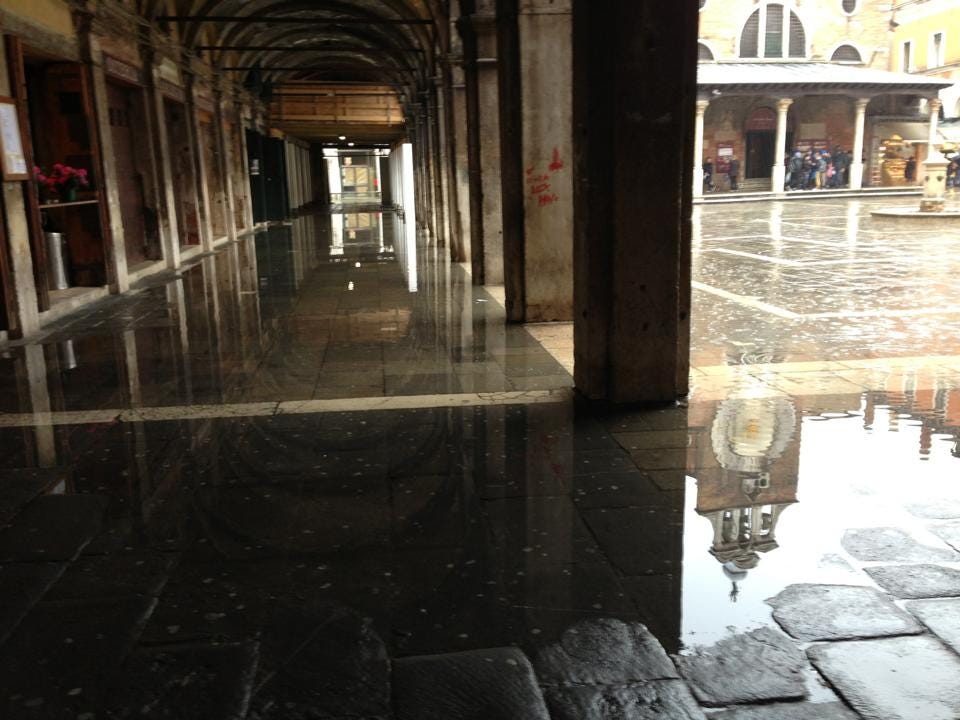The first time I heard the sirens was on October 31, 2004. We had just moved into a ground floor apartment in the Santa Croce neighborhood of Venice, at 143 cm above sea level. It was a windy, rainy day and the sirens were warning us that high water would be arriving within a few hours. The forecast had predicted the water would rise to 130 cm, 13 cm (five inches) below the level where it would enter our apartment. But the science of predicting the water level is based upon rainfall, wind speed, wind direction, and the tides. When the rains come down hard while the strong winds are pushing water into the lagoon, and the tide is high, Venice floods. Predicting the exact level of high water is not easy.
I donned my knee-high waterproof boots and walked through Campo San Giacomo dell’Orio. Water was pouring into the Coop supermarket. Shoppers seemed unfazed as they sloshed their way through the store, making waves with their carts.
The water level had clearly passed the predicted level of 130 cm. Many store owners were lifting their computers and other valuables off the floor and onto their desks. I helped a couple of workers at a take-out pizzeria raise their Coke machine out of danger, balancing it on a stack of restaurant-sized tomato cans. Tourists laughed while walking through ten inches of water, unaware of the dead rodents being transported by the flowing water to a burial at sea.
I arrived home to find a man fixing his boat outside my front door. When I had left, there was an alley outside our apartment. The alley was now a canal, complete with the man and his boat. Water was lapping at our doorway, but had not made its way in.
The next day, we learned that the water had reached 140 cm. Had it been one inch higher, our apartment would have been flooded. Walking the same route as the previous day, I saw Coop employees using pumps to drain the water from the supermarket. Smaller stores and restaurants used brooms to push the sludge out the door. Computers were being placed back under the desks, and the Coke machine placed precariously on the tower of tomatoes had been returned to its original location.
This is the life of Venetians. They live with the ebb and flow of the lagoon. It gives them life, and can also make that life difficult. But there was hope in their hearts. Moses was coming to Venice.
Moses, or MOSE in Italian, is an acronym for the Modulo Sperimentale Elettromeccanico. It’s a system of artificial barriers designed to protect Venice from acqua alta, or high water. Designed in the 1980s, construction began in 2003. A series of 78 floodgates would sit on the bottom of the lagoon, to be raised when a rise in water level was expected to be greater than 110 cm. These gates would keep the water in the lagoon below flood levels. Some sites such as Saint Mark’s Square which flood at lower levels would be protected with supplemental measures.
During the 2013-2014 period, over 50 people including the mayor of Venice were arrested and charged with corruption relating to MOSE amounting to billions of euros, causing delays. Still, the completion was scheduled for 2018. In November of 2019 with MOSE still incomplete, the city flooded, causing billions of euros in damage. But from 2020-2022, the floating barriers were raised frequently on a test basis, proving quite effective.
In January 2023 my wife Debbie and I were visiting Venice and stayed in Dorsoduro along a quiet canal where the banks flood at roughly 100 cm. On our first day there was an inch or two of water on the sidewalk at high tide. The water was predicted to rise to 130 cm the following day, which would put roughly a foot of water at our doorstep. Of course, walking our dog at that tide level would be impossible.
We had forgotten, however, that MOSE was fully operational. When high tide came, our sidewalks were dry, as was the rest of the city. The government claims that every time MOSE has been raised, Venice has been protected as planned. This protection does not come without costs, however. Every time the barriers are raised, it costs over 300,000 euro, amounting to over six euro per resident. It’s a high price, but considering the alternative, that’s a price most Venetians are willing to pay. They are thankful to God that Moses has finally arrived in Venice.







I love this little glimpse into Venetian life.